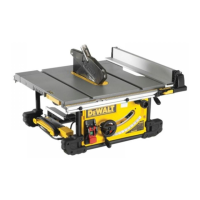21
ENGLISH
When vacuuming dry dust that is especially detrimental to
health or carcinogenic, use dust class M vacuumcleaner.
The blade guard assembly also features a dust exhaust port for
35 mm nozzles (M class vacuum).
• During all operations, connect a dust extraction device
designed in accordance with the relevant regulations
regarding dustemission.
• Ensure that the dust extraction hose in use is suitable for
the application and material being cut. Ensure proper
hosemanagement.
• Be aware that man-made materials such as chipboard
or MDF produce more dust particles during cutting than
naturaltimber.
Storage (Fig. B, Z–CC)
Store the machine in a safe manner when not being used. The
storage location must be dry and lockable. This prevents the
machine from storage damage, and from being operated by
untrainedpersons.
1. Attach push stick
21
tofence.
2. Remove blade guard assembly. See To Remove Blade
Guard Assembly. Slide blade guard assembly
11
into
holder as shown, then turn lock knob 1/4 to lock in place.
Refer to FigureX.
3. Slide blade wrenches
20
into pocket until yellow button
aligns with hole to secure in place, refer to FigureB.
4. Insert guide bar of mitre gauge into pocket until it
bottomsout.
5. Wrap cord in this location
43
. Refer to FigureZ.
6. To store fence, snap work support in stored position.
Remove fence from rails. Reattach fence upside down on
left side of saw, refer to FigureY. DO NOT hook locator slots
on left side fence locator screws. These screws will align
with clearance pocket on fence as shown. Close the rip
fence latches
18
tosecure.
7. Non-through cutting riving knife
52
can be installed in the
saw (working position) or stored along with the blade guard
assembly. Refer to FigureB.
8. Depress the stem on the anti-kickback assembly
53
to
allow the assembly to slide from the riving knife slot.
9. Position anti-kickback assembly into the storage hole as
shown. While depressing stem
54
slide the anti-kickback
assembly across the storage bracket
56
and release pin to
lock into place.
Transporting (Fig. A, B)
Before transportation following has to be done:
• Wrap cord
• Turn the blade height adjustment wheel
6
in anticlockwise
direction until the teeth of the saw blade are positioned
below the saw table. Lock the bevel lock lever
7
.
• Slide the fence rails completely inward and fix it by rail
locklever
5
.
• Always carry the machine using the designated handles
50
,
refer to FiguresA andB.
WARNING: Always transport the machine with the upper
blade guardfitted.
MAINTENANCE
Your
power tool has been designed to operate
over a long period of time with a minimum of maintenance.
Continuous satisfactory operation depends upon proper tool
care and regularcleaning.
WARNING: To reduce the risk of serious personal
injury, turn tool off and disconnect tool from power
source before making any adjustments or removing/
installing attachments or accessories. An accidental
start-up can causeinjury.
Lubrication (Fig. V)
The motor and bearings require no additional lubrication. If
raising and lowering the blade becomes difficult, clean and
grease the height adjustment screws:
1. Unplug the saw from powersource.
2. Turn the saw on itsside.
3. Clean and lubricate the height adjustment screw
threads
42
on the underside of this saw as shown in
FigureT. Use general purposegrease.
Cleaning (Fig. A, U)
WARNING: To reduce the risk of serious personal
injury, turn unit off and disconnect machine from
power source before cleaning. An accidental start-up
can causeinjury.
WARNING: Blow dirt and dust out of the main housing
with dry air as often as dirt is seen collecting in and around
the air vents. Wear approved eye protection and approved
dust mask when performing thisprocedure.
WARNING: Never use solvents or other harsh chemicals
for cleaning the non-metallic parts of the tool. These
chemicals may weaken the materials used in these parts.
Use a cloth dampened only with water and mild soap.
Never let any liquid get inside the tool; never immerse any
part of the tool into aliquid.
WARNING: To reduce the risk of injury, regularly clean
the tabletop.
WARNING: To reduce the risk of injury, regularly clean
the dust collectionsystem.
The blade guard assembly
11
and throat plate must be placed
in position before operating thesaw.
Before use, carefully inspect upper and lower blade guards as
well as the dust extraction tube to determine that it will operate
properly. Ensure that chips, dust or work piece particles cannot
lead to blockage of one of thefunctions.

